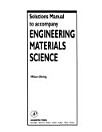Engineering Materials Science
វិច្ឆិកា 1995 · Elsevier
2.5star
ការវាយតម្លៃ 2report
សៀវភៅអេឡិចត្រូនិច
827
ទំព័រ
family_home
មានសិទ្ធិ
info
reportការវាយតម្លៃ និងមតិវាយតម្លៃមិនត្រូវបានផ្ទៀងផ្ទាត់ទេ ស្វែងយល់បន្ថែម
អំពីសៀវភៅអេឡិចត្រូនិកនេះ
Milton Ohring's Engineering Materials Science integrates the scientific nature and modern applications of all classes of engineering materials. This comprehensive, introductory textbook will provide undergraduate engineering students with the fundamental background needed to understand the science of structure-property relationships, as well as address the engineering concerns of materials selection in design, processing materials into useful products, andhow material degrade and fail in service. Specific topics include: physical and electronic structure; thermodynamics and kinetics; processing; mechanical, electrical, magnetic, and optical properties; degradation; and failure and reliability. The book offers superior coverage of electrical, optical, and magnetic materials than competing text.The author has taught introductory courses in material science and engineering both in academia and industry (AT&T Bell Laboratories) and has also written the well-received book, The Material Science of Thin Films (Academic Press).Key Features* Provides a modern treatment of materials exposing the interrelated themes of structure, properties, processing, and performance* Includes an interactive, computationally oriented, computer disk containing nine modules dealing with structure, phase diagrams, diffusion, and mechanical and electronic properties* Fundamentals are stressed* Of particular interest to students, researchers, and professionals in the field of electronic engineering
ការដាក់ផ្កាយ និងមតិវាយតម្លៃ
2.5
ការវាយតម្លៃ 2
អំពីអ្នកនិពន្ធ
Dr. Milton Ohring, author of two previously acclaimed Academic Press books,The Materials Science of Thin Films (l992) and Engineering Materials Science (1995), has taught courses on reliability and failure in electronics at Bell Laboratories (AT&T and Lucent Technologies). From this perspective and the well-written tutorial style of the book, the reader will gain a deeper physical understanding of failure mechanisms in electronic materials and devices; acquire skills in the mathematical handling of reliability data; and better appreciate future technology trends and the reliability issues they raise.
វាយតម្លៃសៀវភៅអេឡិចត្រូនិកនេះ
ប្រាប់យើងអំពីការយល់ឃើញរបស់អ្នក។
អានព័ត៌មាន
ទូរសព្ទឆ្លាតវៃ និងថេប្លេត
ដំឡើងកម្មវិធី Google Play Books សម្រាប់ Android និង iPad/iPhone ។ វាធ្វើសមកាលកម្មដោយស្វ័យប្រវត្តិជាមួយគណនីរបស់អ្នក និងអនុញ្ញាតឱ្យអ្នកអានពេលមានអ៊ីនធឺណិត ឬគ្មានអ៊ីនធឺណិតនៅគ្រប់ទីកន្លែង។
កុំព្យូទ័រយួរដៃ និងកុំព្យូទ័រ
អ្នកអាចស្ដាប់សៀវភៅជាសំឡេងដែលបានទិញនៅក្នុង Google Play ដោយប្រើកម្មវិធីរុករកតាមអ៊ីនធឺណិតក្នុងកុំព្យូទ័ររបស់អ្នក។
eReaders និងឧបករណ៍ផ្សេងទៀត
ដើម្បីអាននៅលើឧបករណ៍ e-ink ដូចជាឧបករណ៍អានសៀវភៅអេឡិចត្រូនិក Kobo អ្នកនឹងត្រូវទាញយកឯកសារ ហើយផ្ទេរវាទៅឧបករណ៍របស់អ្នក។ សូមអនុវត្តតាមការណែនាំលម្អិតរបស់មជ្ឈមណ្ឌលជំនួយ ដើម្បីផ្ទេរឯកសារទៅឧបករណ៍អានសៀវភៅអេឡិចត្រូនិកដែលស្គាល់។






